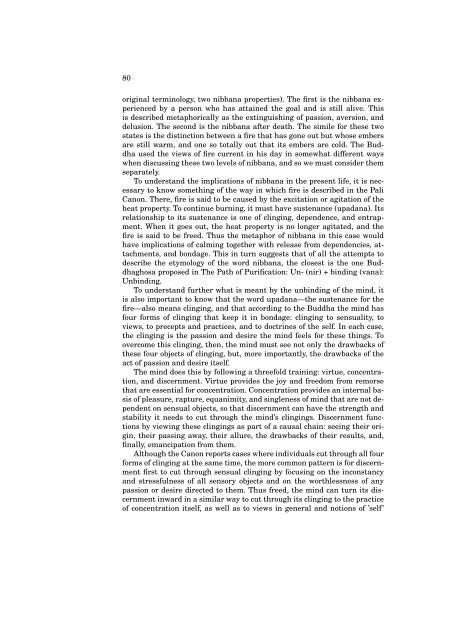Philosophy 438 Indian Buddhist Philosophy Buddhist Views of the ...
Philosophy 438 Indian Buddhist Philosophy Buddhist Views of the ...
Philosophy 438 Indian Buddhist Philosophy Buddhist Views of the ...
Create successful ePaper yourself
Turn your PDF publications into a flip-book with our unique Google optimized e-Paper software.
80<br />
original terminology, two nibbana properties). The first is <strong>the</strong> nibbana experienced<br />
by a person who has attained <strong>the</strong> goal and is still alive. This<br />
is described metaphorically as <strong>the</strong> extinguishing <strong>of</strong> passion, aversion, and<br />
delusion. The second is <strong>the</strong> nibbana after death. The simile for <strong>the</strong>se two<br />
states is <strong>the</strong> distinction between a fire that has gone out but whose embers<br />
are still warm, and one so totally out that its embers are cold. The Buddha<br />
used <strong>the</strong> views <strong>of</strong> fire current in his day in somewhat different ways<br />
when discussing <strong>the</strong>se two levels <strong>of</strong> nibbana, and so we must consider <strong>the</strong>m<br />
separately.<br />
To understand <strong>the</strong> implications <strong>of</strong> nibbana in <strong>the</strong> present life, it is necessary<br />
to know something <strong>of</strong> <strong>the</strong> way in which fire is described in <strong>the</strong> Pali<br />
Canon. There, fire is said to be caused by <strong>the</strong> excitation or agitation <strong>of</strong> <strong>the</strong><br />
heat property. To continue burning, it must have sustenance (upadana). Its<br />
relationship to its sustenance is one <strong>of</strong> clinging, dependence, and entrapment.<br />
When it goes out, <strong>the</strong> heat property is no longer agitated, and <strong>the</strong><br />
fire is said to be freed. Thus <strong>the</strong> metaphor <strong>of</strong> nibbana in this case would<br />
have implications <strong>of</strong> calming toge<strong>the</strong>r with release from dependencies, attachments,<br />
and bondage. This in turn suggests that <strong>of</strong> all <strong>the</strong> attempts to<br />
describe <strong>the</strong> etymology <strong>of</strong> <strong>the</strong> word nibbana, <strong>the</strong> closest is <strong>the</strong> one Buddhaghosa<br />
proposed in The Path <strong>of</strong> Purification: Un- (nir) + binding (vana):<br />
Unbinding.<br />
To understand fur<strong>the</strong>r what is meant by <strong>the</strong> unbinding <strong>of</strong> <strong>the</strong> mind, it<br />
is also important to know that <strong>the</strong> word upadana—<strong>the</strong> sustenance for <strong>the</strong><br />
fire—also means clinging, and that according to <strong>the</strong> Buddha <strong>the</strong> mind has<br />
four forms <strong>of</strong> clinging that keep it in bondage: clinging to sensuality, to<br />
views, to precepts and practices, and to doctrines <strong>of</strong> <strong>the</strong> self. In each case,<br />
<strong>the</strong> clinging is <strong>the</strong> passion and desire <strong>the</strong> mind feels for <strong>the</strong>se things. To<br />
overcome this clinging, <strong>the</strong>n, <strong>the</strong> mind must see not only <strong>the</strong> drawbacks <strong>of</strong><br />
<strong>the</strong>se four objects <strong>of</strong> clinging, but, more importantly, <strong>the</strong> drawbacks <strong>of</strong> <strong>the</strong><br />
act <strong>of</strong> passion and desire itself.<br />
The mind does this by following a threefold training: virtue, concentration,<br />
and discernment. Virtue provides <strong>the</strong> joy and freedom from remorse<br />
that are essential for concentration. Concentration provides an internal basis<br />
<strong>of</strong> pleasure, rapture, equanimity, and singleness <strong>of</strong> mind that are not dependent<br />
on sensual objects, so that discernment can have <strong>the</strong> strength and<br />
stability it needs to cut through <strong>the</strong> mind’s clingings. Discernment functions<br />
by viewing <strong>the</strong>se clingings as part <strong>of</strong> a causal chain: seeing <strong>the</strong>ir origin,<br />
<strong>the</strong>ir passing away, <strong>the</strong>ir allure, <strong>the</strong> drawbacks <strong>of</strong> <strong>the</strong>ir results, and,<br />
finally, emancipation from <strong>the</strong>m.<br />
Although <strong>the</strong> Canon reports cases where individuals cut through all four<br />
forms <strong>of</strong> clinging at <strong>the</strong> same time, <strong>the</strong> more common pattern is for discernment<br />
first to cut through sensual clinging by focusing on <strong>the</strong> inconstancy<br />
and stressfulness <strong>of</strong> all sensory objects and on <strong>the</strong> worthlessness <strong>of</strong> any<br />
passion or desire directed to <strong>the</strong>m. Thus freed, <strong>the</strong> mind can turn its discernment<br />
inward in a similar way to cut through its clinging to <strong>the</strong> practice<br />
<strong>of</strong> concentration itself, as well as to views in general and notions <strong>of</strong> ’self’
















